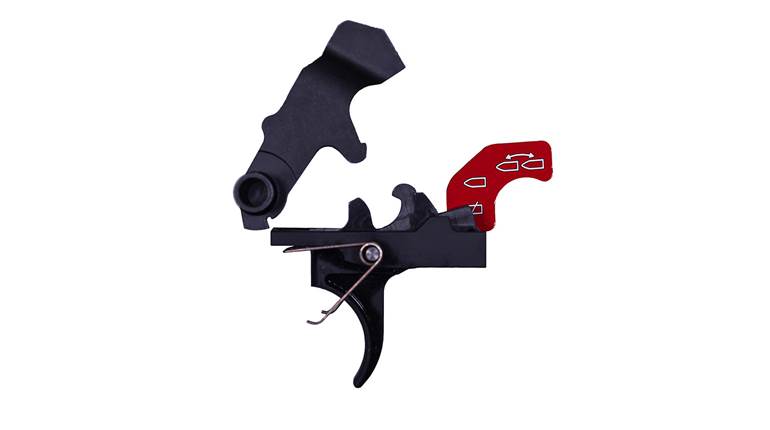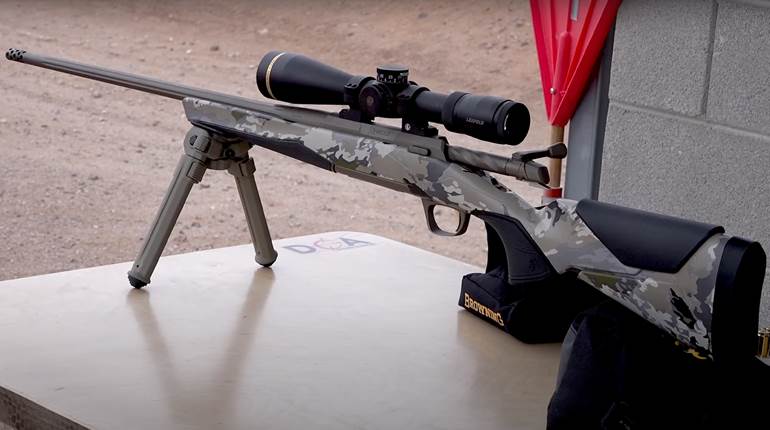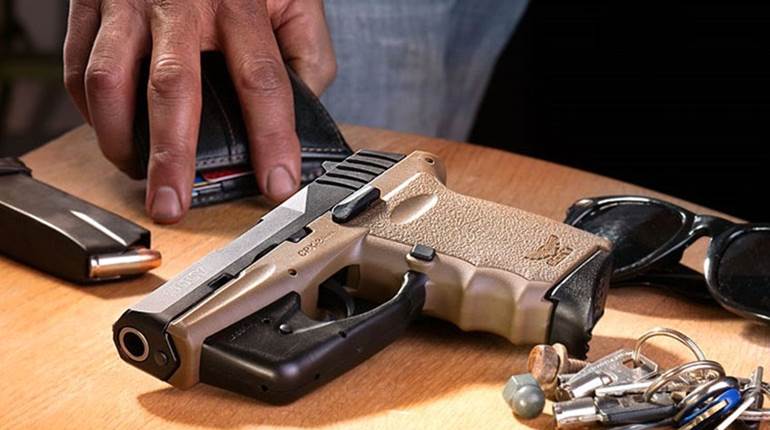
At long last, the SCAR 17S is here. The new rifle is a semi-automatic-only version of the military’s selective-fire MK17 Mod 0 or Special Operations Combat Assault Rifle (SCAR) Heavy. Chambered in .308 Win./7.62x51 mm NATO, the gun is bigger and more powerful than its .223 Rem./5.56x45 mm NATO predecessor, the SCAR 16S, but, thankfully, not objectionably so. No longer constrained by limitations of that gun’s smaller receiver and chambering, the bigger SCAR 17S greatly expands the potential utility of the SCAR platform. One can argue that the SCAR Heavy was what Special Operations Command (SOCOM) wanted all along: a modern carbine chambered in 7.62x51 mm NATO that is lightweight, reliable and accurate.
SOCOM adopted both the SCAR Heavy and the SCAR Light in November 2004, and since that time both military and civilian shooting circles have taken to the new gun. Those who shoot AR-style rifles for service or sport will find themselves right at home. The bolt stop paddle, magazine-release button and safety lever are in the same places, and the latter two controls are now ambidextrous. The bolt stop paddle is almost identical to that of the AR-15, but the circular magazine release button is taller and wider, so it is easier to find in a hurry. Major differences between the SCARs and ARs include the SCAR charging handle, which reciprocates with the bolt. The handle can be switched from the left to the right side, so both right- and left-handed shooters can choose whether they want to operate it with either their strong or weak hands. In addition, the safety lever has a short, 45-degree throw between the safe and fire positions, whereas that of the M16/AR-15 has a longer, 90-degree throw.
The seven-lug bolt has a deeply recessed face with a plunger ejector and a claw extractor. There are a number of mechanical features that help ensure the 17S’s multi-lug bolt seats consistently into battery. The mass of the bolt assembly combined with the mechanical advantage of the SCAR’s fixed charging handle eliminates any need for a forward assist plunger.
As one can imagine, these improvements greatly simplify the immediate action drill. In the event of a stoppage, there is no need to tap a separate forward assist after you pull and release the charging handle. Also, there is no charging handle to pull over the top of the stock, so one can keep his or her head on the stock when reducing a stoppage to get the gun back into action that much faster. The stock also has a two-position adjustable comb. Given that many of the powerful optical sights currently available require the use of tall rings and bases, this is an important feature.
Its six-position collapsing stock is indexed on both sides. Compressing a metal release bar on the left-hand side of the stock allows the user to adjust length of pull, and depressing a half-moon-shaped button at the wrist folds the stock to the right side of the receiver. A stud on the comb locks into a hook at the rear of the ejection port that doubles as a shell deflector. The hook is just a friction lock, so a sharp pull on the butt of the stock will release it from the hook.
The SCAR 17S has a number of sling attachment points. At the stock’s wrist are two vertical sling loops on the left-hand side and one on the right. Two more vertical sling loops are fixed to the mouth of the fore-end. Last, a horizontal slot runs through the stock’s heel.
A 37-position M1913 Picatinny rail runs the full length of the aluminum alloy upper receiver. The rail runs all the way from the gas block to the wrist of the stock. The mounting points are indexed so it is easier to quickly reinstall optical sights without altering zero or eye relief. Also there is no slip ring on the one-piece upper receiver that can create steps and gaps to complicate scope mounting.
The polymer lower receiver has a larger magazine well to accommodate FNH USA’s proprietary double-column, detachable box magazine. The magazine, of which 10- and 20-round variants are available, has a stamped steel body and a polymer follower, and the floorplate has a wedge-shaped extension that gives the magazine the appearance of having a flat bottom.
Detachable flip-up iron sights are included. The rear aperture overlaps the circular shroud for the front sight—a system first seen on the G3/H&K-91 that aids rapid sight alignment. The front post is detent-adjustable for elevation. Vertical drums located on both sides of the rear sight base provide adjustment for windage, and a horizontal wheel at the foot of the rear aperture indexed from 200 to 600 meters allows adjustment for range.
The cold-hammer forged barrel has a moderate profile. It measures 0.66 inches in diameter and is 161/4-inches long. The twist rate is 1:12 inches. Fabrique Nationale chose a four-prong triple-baffle muzzle brake from Primary Weapon Systems. The free-floating barrel is attached to the receiver via six Torx-head machine screws. Swapping out a barrel requires a Torx wrench with a proper torque setting and takes about five minutes. FNH-USA states that when SCAR barrels are swapped, loss of zero should be limited to less than 1 inch at 100 yards.
The single-stage trigger of our test gun broke at 6 pounds, 5 ounces. There was no creep, slack or stacking and overtravel was minimal. For testing I chose a Leupold Mark 8 CQBSS scope. With its 1.1-8X magnification range and precision reticle it was the right tool for exploring the accuracy potential of the SCAR 17S. (An evaluation of the new Leupold will appear next month).
The SCAR 17S is about 1 pound heavier, and the receiver is about 1/2-inch longer than a SCAR 16S. The extra bulk was noticeable when picking up one gun then the other, but much less than one would expect when stepping up from 5.56 mm NATO to 7.62 mm NATO. The stock is the same size as that of the lighter gun, as is the grip. Additionally, the size and placement of all of the controls, including the charging handle, selector lever, magazine release and bolt stop lever, are identical. The balance point of two guns is in the same place and the gun is anything but muzzle-heavy. In terms of handling and ergonomics, transitioning between the two guns was a snap. The extra weight was not readily apparent when the gun was first picked up, but after a dozen or more simulated action-style shooting stages there was no denying it was a bigger, heavier gun.
Unadorned, the gun is very svelte and handy for a .308 Win. semi-automatic carbine, but if you mount a heavy scope or drape the fore-end with a lot of accessories, I think you are going to find a vertical fore-grip an outright necessity. The mechanical rhythm of the gun (the lock time of the trigger system and the dwell time of the bolt) was similar to its lighter counterpart, but the extra recoil of the .308 Win. round required significantly greater recovery time. Just how much of a penalty this will exact in terms of engagement time will depend on the shooter’s skill, body size and mindset. In short, the better the shooter is able to cope with the extra recoil, the more he will get out of the rifle.
I am a left-handed shooter, but I wanted to try shooting it without reversing the charging handle, thinking there might be some advantage to working with my strong hand. But I found that the charging handle kept brushing against my fingers as the bolt cycled. Naturally, that wouldn’t be a problem if I used a vertical fore-grip or disciplined myself to keep my support hand glued to the front of the magazine well. In the end I switched the charging handle over to the right side of the gun. I felt like I had punted, but it really made more sense to work the bolt with my support hand since it was already in motion swapping magazines. It also kept my working hand in front of my face, rather than hidden by the receiver, which makes for smoother work in almost any endeavor conducted in a high-stress environment, whether that be a timed Heavy Metal match or a self-defense situation.
From my point of view, the arrival of the semi-automatic SCAR in .308 Win., though belated, is most welcome. Reliable and accurate, it is easy to see why it is the .308 Win. carbine of choice for our elite troops. When SOCOM originally wrote the specifications for the proposed SCAR, one of the main requirements was the ability to shoot a variety of calibers, up to and including .308 Win. One might say that the SCAR Heavy is what SOCOM’s operators wanted all along. The arrival of the SCAR 17S greatly expands the potential of the SCAR platform.
See American Rifleman Editor-in-Chief Mark Keefetrying outthe FNH SCAR MK17 Mod 0.
Importer: FNH-USA; (703) 288-1730; www.fnhusa.com
Caliber: .308 Win./7.62x51 mm NATO
Action Type: gas-operated, semi-automatic center-fire rifle
Receiver: aluminum upper and polymer lower
Barrel: 16¼", cold-hammer forged, chrome-lined
Rifling: six-groove, 1:12" RH twist
Magazine: 10- or 20-round detachable box
Sights: flip-up front post detent-adjustable for elevation (1-minute clicks); folding rear aperture finger-adjustable for windage (1/2-minute clicks) and range (200-600 meters); Picatinny rail
Trigger Pull: non-adjustable, single-stage; 6 lbs., 5 ozs.
Stock: folding synthetic: length of pull, six-position adjustable in 1/2" increments from 141⁄8" to 115⁄8"; drop at heel, 11⁄4"; drop at comb, 1/8", 0" (comb raised)
Overall Length: 381⁄2" (buttstock extended) 281⁄2" buttstock folded
Weight: 8 lbs.
Accessories: one 10- or 20-round magazine, owner’s manual
Suggested Retail Price: $3,349






































